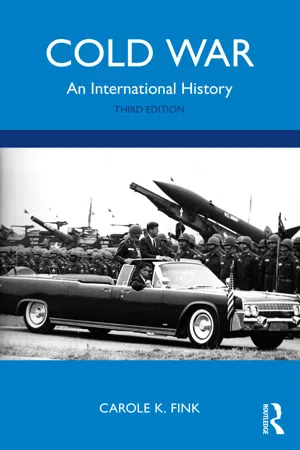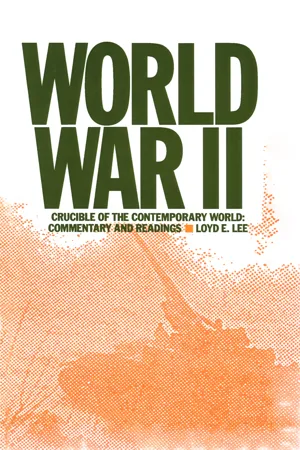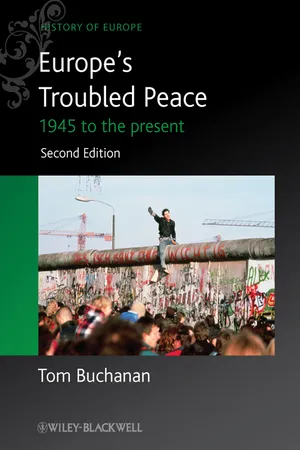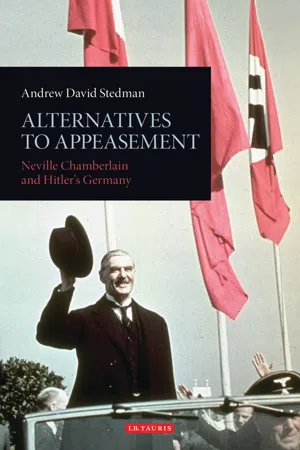History
The Grand Alliance
The Grand Alliance refers to the coalition formed during World War II between the United States, the Soviet Union, and the United Kingdom. This alliance was instrumental in defeating the Axis powers and shaping the post-war world order. The cooperation between these major powers laid the foundation for the United Nations and set the stage for the Cold War.
Written by Perlego with AI-assistance
Related key terms
4 Key excerpts on "The Grand Alliance"
- eBook - ePub
Cold War
An International History
- Carole K. Fink(Author)
- 2021(Publication Date)
- Routledge(Publisher)
2 The Grand Alliance, 1941–1945DOI: 10.4324/9780429356681-3The war you are waging is a war of liberation, a just war.Joseph Stalin, Speech at the Red Army Parade, November 7, 1941Never before have the major Allies been more closely united – not only in their war aims but also in their peace aims. And they are determined to continue to be united with each other – and with all peace-loving Nations – so that the ideal of lasting peace will become a reality.Franklin D. Roosevelt, Address to Congress on the Yalta Conference, March 1, 1945World War II created powerful patriotic myths among the three victors of the Battles of Britain, Stalingrad, and Iwo Jima, but there is no shared public remembrance of the coalition that finally, and at very great cost, defeated the Axis powers in 1945. What Winston Churchill grandiosely dubbed The Grand Alliance was in fact a coalition of three highly disparate partners that dissolved almost immediately when the fighting was over. Even in wartime, the alliance was unstable, often lacking cohesion and mutual confidence and buffeted by alarming intelligence reports and bad news from the battlefield. A reexamination of The Grand Alliance thus requires us to peel away more than a half century of Cold War memoirs and accounts, amalgamate three separate national narratives – of America’s “Good War,” the Soviet Union’s “Great Patriotic War,” and Great Britain’s heroic defense of its homeland and empire – and reappraise this brittle, ephemeral, but also indispensable partnership.Disparate Partners
There were, of course, considerable differences among the three. The Soviet Union, extending 8.6 million square miles between the Baltic and the Pacific, was the world’s largest country, with nearly 200 million people, vast mineral deposits, and an economy that had made spectacular gains in heavy industry during the three Five-Year Plans between 1928 and 1941.1 - eBook - ePub
World War Two: Crucible of the Contemporary World - Commentary and Readings
Crucible of the Contemporary World - Commentary and Readings
- Lily Xiao Hong Lee(Author)
- 2016(Publication Date)
- Routledge(Publisher)
Part VI How Grand Was The Grand Alliance?- Introduction
- 13. The Economics of Partnership Robert M. Hathaway
- 14. Adherence to Agreements: Yalta and the Experiences of the Early Cold War Melvyn P. Leffler
- Further Reading for Part VI
The term “The Grand Alliance,” the title of the third volume of Winston Churchill’s monumental history of the Second World War, helped mold all subsequent thinking about wartime diplomacy and coalition fighting among the Big Three: Great Britain, the United States and the Soviet Union. In emphasizing a “special relationship” between himself and American president Franklin D. Roosevelt, and between their respective “Anglo-Saxon” peoples, the prime minister launched a second theme with great appeal to Anglo-American public opinion during the early years of the cold war. Both ideas contain kernels of historical truth, but both also disguise deeply rooted differences in interests and goals within the alliance. Realistically, this should be expected for great nations respond to their own peculiar historic developments; each has its own perceptions and requirements.Given Hitler’s reckless determination to have a war, his strategic miscalculations, and his underestimation of his opponents’ will to survive, the combination of powers arrayed against Germany after 1941 seems inevitable. The coalition of the United States of America, the British Empire and Commonwealth, and the Union of Soviet Socialist Republics and their dozens of allies, however, was not inevitable. Though the troubled times of the late thirties led many to believe that war was very likely, nothing would have struck even well-informed people as more improbable than The Grand Alliance. Their conflicting interests drove them apart. Hitler was not alone in ruling out their international cooperation. But he was nearly alone in making the impossible happen (see Part I above).What brought the alliance together was not resistance to aggression and tyranny. Of the Big Three, only the United Kingdom (the accurate, though less-often used name, since it includes both Great Britain and Northern Ireland), along with France and some members of the Commonwealth, came to Poland’s defense in early September 1939. Stalin, in fact, invaded Poland shortly after the Germans in order to claim the eastern half of the country promised in the Nonaggression Pact the month before. Roosevelt, as he had so often done in the years before, offered only words. Congress did amend the neutrality acts to permit France and Britain to buy war materials, but still required them to pay in cash and to carry their purchases away in non-American ships. - eBook - ePub
Europe's Troubled Peace
1945 to the Present
- Tom Buchanan(Author)
- 2011(Publication Date)
- Wiley-Blackwell(Publisher)
2 Europe between the Powers, 1945–1953 From Grand Alliance to Cold War, 1941–1947 On April 25, 1945 an advanced US patrol encountered Soviet troops on the River Elbe. Photographs record a moment of soldierly joy and relief: vodka was produced and there was wild dancing (see Figure 2.1). Yet there was also a touch of solemnity as an American lieutenant appealed to both sides to remember this day. One former GI recalled that “There were tears in the eyes of most of us. Perhaps a sense of foreboding that things might not be as perfect in the future as we anticipated.” 1 In fact, barely 18 months later, amidst a welter of suspicion and bad faith, relations between the victorious powers had all but collapsed, while temporary zones of occupation were rapidly hardening into the postwar division of Europe. However, this incipient “Cold War” – so formative for the development of Europe over the next four decades – not only reflected the choices made by the powers after the defeat of Nazism but also the tensions within the wartime Grand Alliance itself. This chapter examines the nature of this unprecedented external intrusion into Europe’s affairs, while Chapter 3 will look at how – within the context of the Cold War – the Europeans forged a new political and social order after 1945. The Grand Alliance was above all a coalition devised to win the war. The prime objective on both sides was to hold it together until the defeat of Germany (and subsequently Japan) and to prevent any possibility of a separate peace. Detailed arrangements for the postwar world were, in general, shelved until the general peace settlement which never materialized. 2 The Casablanca agreement of January 1943, which committed Britain and the USA to the pursuit of unconditional victory, guided Allied policy more clearly in the last years of the war than did the Atlantic Charter of August 1941, which had proposed a postwar world founded on freedom and self-determination - eBook - ePub
Alternatives to Appeasement
Neville Chamberlain and Hitler's Germany
- Andrew David Stedman(Author)
- 2014(Publication Date)
- I.B. Tauris(Publisher)
4 ALLIANCESIntroductionIf a number of states were assembled around Great Britain and France in a solemn treaty for mutual defence against aggression; if they had their forces marshalled in what you may call a Grand Alliance ... and if it were done in the year 1938 – and, believe me, it may be the last chance there will be for doing it – then I say you might even now arrest this coming war.1(Winston Churchill, House of Commons, March 1938)A large body of Chamberlain’s critics, amongst contemporaries and historians alike, have suggested that the National Government should have pursued a policy of alliances as an alternative to appeasement in the years before war. Indeed, Churchill’s famous notion of the ‘Grand Alliance’, first advocated following the Anschluss , has emerged as perhaps the favourite rival strategy of those later appeasement detractors who like to imagine scenarios of what might have been. Whether envisaged as the spurned deterrent that could have driven Hitler away from war, or as the best means to have won the battle once it was joined, the option of an anti-Fascist bloc of nations is probably the most popularly explored alternative among scholars looking back on this period. It is, therefore, central to this study.For the purposes of this chapter, an alliance or pact is considered to be a formal treaty between two or more powers, usually military in character as a pledge to defend one another from attack. Such agreements as guarantees, blocs and fronts, however, will also be considered under this broad umbrella. A guarantee could indicate a partnership between two powers that did not quite constitute a formal alliance, which were typically reciprocal in nature. A bloc or front could well comprise a more informal grouping of many countries, often in close geographical proximity and with several smaller alliances at its heart. Calls for ‘closer relations’ between powers, moreover, need not represent any such binding arrangement at all. Many of these terms were actually interchangeable at the time, as will become clear.
Learn about this page
Index pages curate the most relevant extracts from our library of academic textbooks. They’ve been created using an in-house natural language model (NLM), each adding context and meaning to key research topics.



